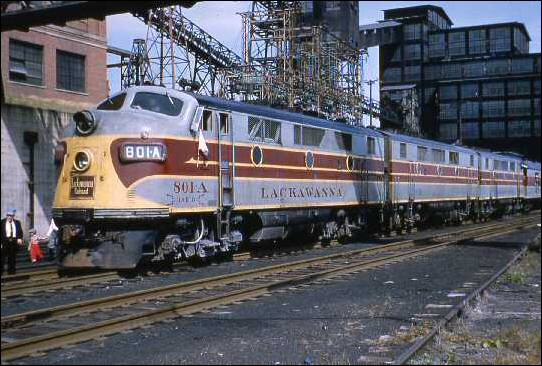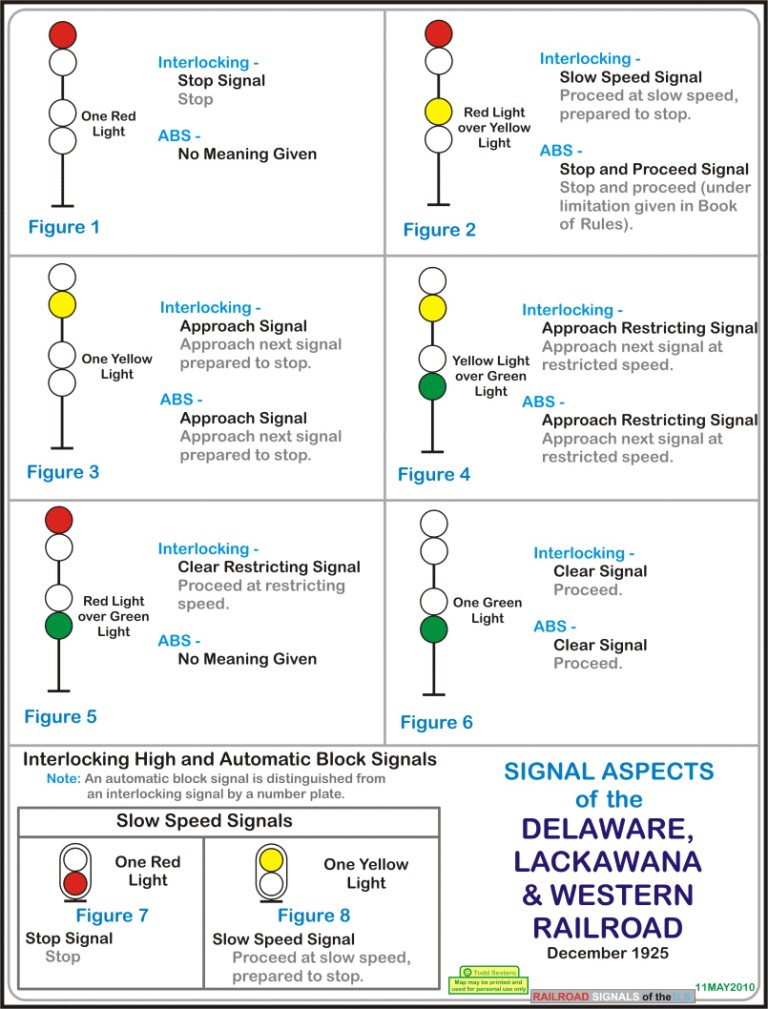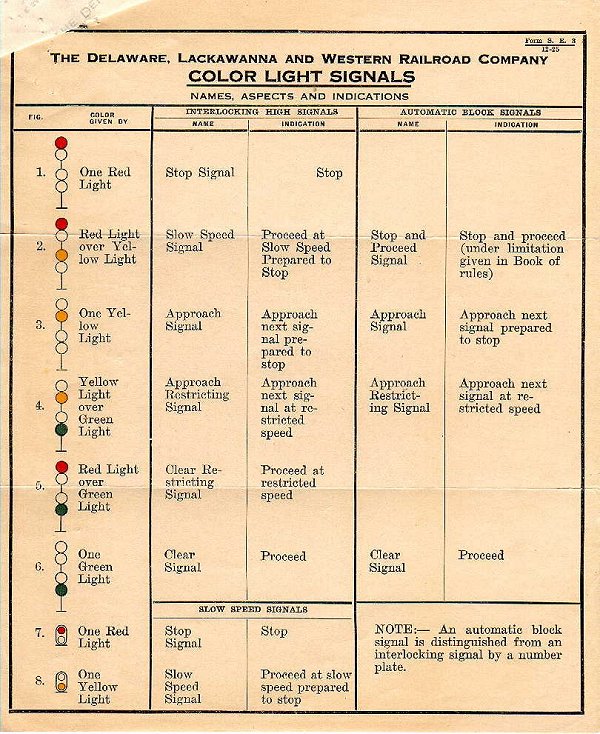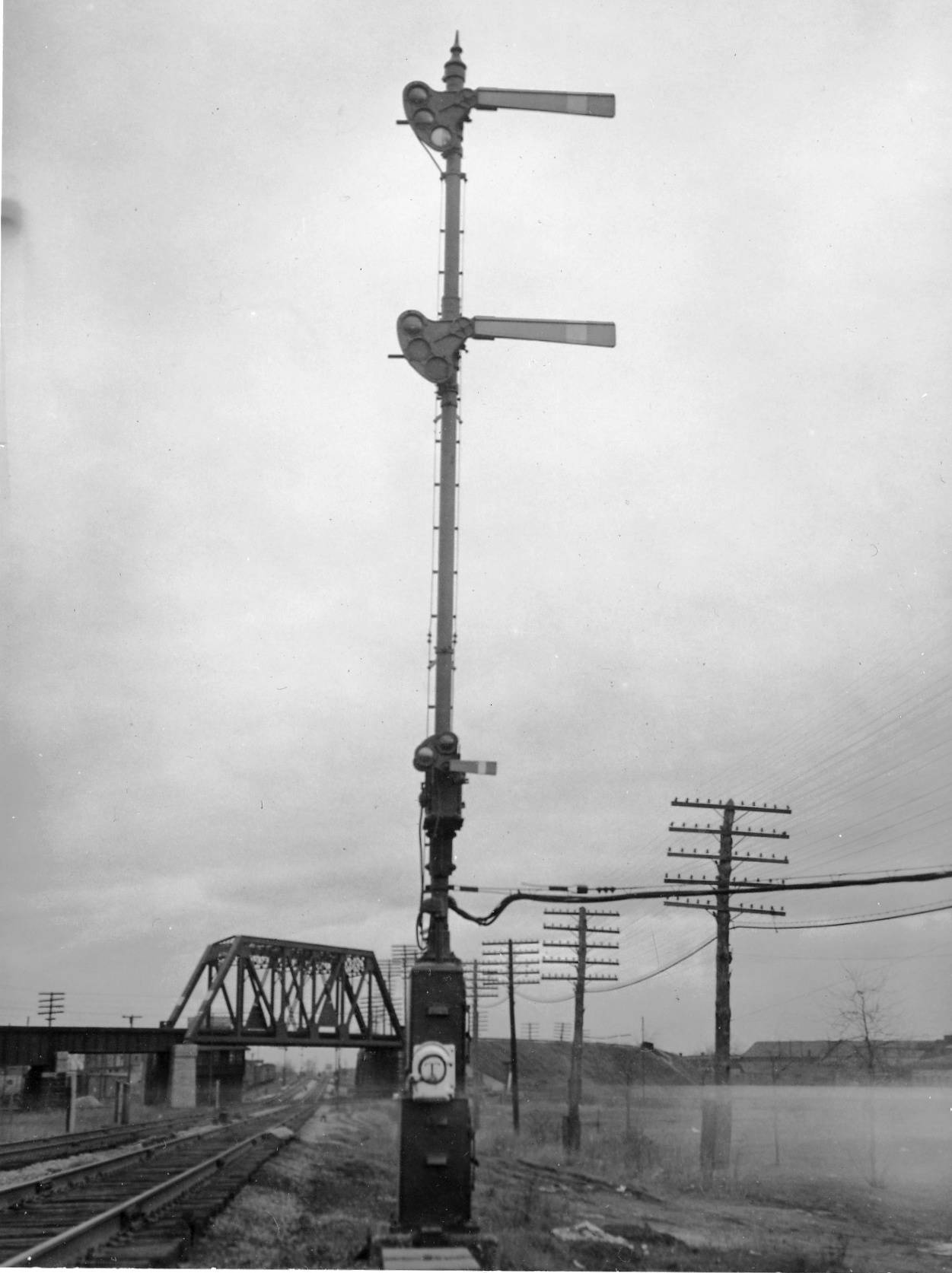



RAILFAN GUIDES HOME
RAILROAD SIGNALS HOME

Click here for the above reference chart in a PDF version.

DL&W Signal Discussions
These are some of the discussions I have come across during my search for DL&W signal information, I don't know the particulars for the DL&W, so I can not vouch for the authenticity of the information these guys are talking about, but nevertheless, it is interesting reading.... Todd (Edited for grammar and punctuation)
From a thread in July of 2002.....
Opposed pairs of three-light signals were used exclusively on
the single-track Gladstone Branch prior to re-electrification and installation
of TCS. The system was designated as an "Absolute and Permissive Block System".
Signals at the "far" end of passing sidings were "Absolute", and were designated
by a number board below the target. A Stop indication (red) on one of these
signals could not be passed except on written order. (This necessitated the
location of telephone boxes at the ends of sidings.) On all other
signals, at the "near" end of a siding or between sidings, a red light indicated
"stop and proceed at restricted speed." In this case restricted speed would be
slow enough to stop short of any obstruction ahead. In addition,
each manned station (except Gladstone) had a roof-mounted "order board"
semaphore signal which could be manually set by the agent/operator, indicating
that written orders were to be picked up. These dated back to the railroad's
original construction, but remained for emergency use as long as there were
agents who could copy orders! Kent Loudon
Kent, has most of this correct, but I would like to point out a few
technicalities related to the Stop signals, and Stop and Proceed signals
encountered at the passing sidings. The APB (Absolute Permissive Block),
that was used on the P&D, ( Gladstone Line) was unique. It gave a clear
block to any train, in any direction, at any time, until one train encountered
another. Then the three block system, CLEAR, APPROACH, and STOP AND
PROCEED, indications would go into effect. I was fortunate to have
worked on the line with some great Conductors and Engineers who would make a
science of meets. By watching when the opposing train set the yellow either on
the signal one block before the meet, approaching the meet, or at the far end of
the passing siding, would determine if you backed in, (NOT COPASETIC BY THE RULE
BOOK), or you pulled in. They would have this down to within seconds on
which way to proceed. This was calculating down to within 30 seconds
exactly how long it would
take to reach the siding, and the time you would need to make all the necessary
moves at the siding. This is when everybody's watch better be correct to
the exact second and everything was a hand thrown switch. You better know
exactly what your assignment was at each end of the siding, in what order things
were to be done, where to stand to give a good hand signal, and where to go
after you closed up, etc, etc. One of the most read pages in the entire
employees time table was the page dealing with rights of opposing trains, and
especially on the P&D. I remember sitting with crews in the mornings just
after going on duty. One member would have a small pocket radio tuned to
WOR on the AM dial. Ever ten minutes or so they would say the time is, (example)
5:40am riiiiiiiighttttttttttttt, and six guys would say NOW in unison. An if you
were out of unison, you made sure you took that into account for that the rest
of the day, or got your watch set correctly. You got a stop and proceed
signal, which had a number board, entering the passing sidings if the opposing
train was already in the RED. This was simply a, toot toot, and way you
went at restricted speed. No need to talk to anyone at Stop and Proceeds.
You got a Stop signal, which had no number board, at the other end of the
siding, until the opposing train was by you. At the Stop signal, where the
term Absolute came from, you did not leave without permission, and a
clearance form B. Without the Clearance form B, if you couldn't reach the
dispatcher, a flagman was supposed to proceed the move on the ground to the next
block signal. Permission was received at the phone box like Kent said, but 98%
of the time you talked directly to the Dispatcher, not the agent/operator.
You might try the short line if the Dispatcher was not coming on the open line,
and then the agent would intervene on your behalf. Maybe by the bell
phone, if the Block Line was out further east. A little trick you learned
when taking promotion in order to remember the open Train Order offices was the
saying, Mothers Milk Better By Far. > Mothers Murray Hill
> Milk Millington > Better Basking Ridge > By
Bernardsville > Far Far Hills This was to remember the
Train Order Offices. NOT the passing sidings. Not every train order
office was at a passing siding, and not every siding was at a train order
office. Passing Sidings were at Murray Hill, Berkley Heights, Sterling,
Millington, Lyons siding, Bernardsville, and Far Hills. These sidings were
the only place you could find a stop signal other than leaving Gladstone, (
first signal) and Summit entering and leaving the Branch. I don't know,
but it seems to me that when the siding were made remote control, and later when
the Branch was CTCed this may have been the last place in the country where this
type of operation was layed out everyday, especially on the scale that it was?
It was the last old time Railroading, at least around here. Maybe in
Canada or Mexico there is still such a branch, or line, but I'm sure it doesn't
have the sheer number of trains the P&D did. Does anyone know of any
passenger, hand operated, time table authority, meets anywhere in North America?
Bob Bahrs
From a thread on www.railroad.net dated September 2004
Well here is a link to a DL&W Rule Book dated April 27, 1952 about 11 months after the photo on the cover of classic trains was taken. It doesn't appear to shed any light on the matter as all I see are two position automatics. not three. Checking the only EL Rule Book I have handy gives the same general info as the 1952 book. Cactus Jack (The link was bad... Todd)
The lower quadrant semaphore signals on the DL&W and most other
eastern railroads used two positions for each arm. The purpose of the two
red roundels in the top arm and the two yellow roundels in the bottom arm were
to cause the signal to display the more restrictive aspect while the arm was in
motion, or not fully lowered to the less restrictive position. The top
arm, being red with a pointed end, was the home signal portion of a two-arm
automatic signal, indicating the condition of the block immediately in advance
of the signal. It was controlled by the H (Home) relay, which was in turn
controlled by all of the track relays and switch circuit controllers in that
block. The lower arm, being yellow with a forked end, was the distant
signal portion of a two-arm automatic signal. It was controlled by the D
(Distant) relay, which was in turn controlled by contacts on the H relay at the
next signal in advance and the H relay at the immediate signal, mentioned above.
The distant signal governed the approach to the next signal in advance.
When the block immediately in advance of this signal was occupied or otherwise
not clear, the top arm was horizontal, as was the lower arm, account of its
control by the same H relay. When the block immediately in advance was clear and
the next block in advance was occupied, the top arm was diagonal below
horizontal, and the lower arm was horizontal, its D relay being de-energized by
the next H relay in advance. When both blocks were clear, both the H and D
relays were energized, and both arms were diagonal below horizontal. So
that signal with its two arms could display aspects conveying three indications
- "Clear," Green over Green, "Approach," Green over Yellow, and "Stop and
Proceed," Red over Yellow. If it were an absolute signal that could
display a "Stop" indication, the top arm would have a red square end blade, and
there would be no number plate on the mast. At some locations where blocks
were considerably longer than the maximum stopping distance, home and distant
signals were at different locations. The single-arm home signal (red arm)
governed the entrance to the block, and the single-arm distant signal (yellow
arm) somewhere in the block governed the approach to the next signal in advance.
By the way, the three-position upper-quadrant semaphores on the Erie used yellow
blades west of Port Jervis, and red reflectorized blades on the New Jersey and
New York RR. In the 1964 EL Book of Rules the colors of the blades were not
significant, but the shapes of the ends were. Gordon Davis
From a blog on the Erie-Lackawanna list dated
March 2008
I remember being at Suffern on a Saturday in the late
1980's/early 1990's when they were rearranging one of the tracks just east of SF
Tower (I think this was when one/two tracks was being removed from service out
of the original 4) and there were a couple of w/b semaphore dwarfs there just
east of the tower - After photographing them, I remember asking the foreman
about getting one, but he said they were "destined for a new home" (I'm assuming
in some foreman's basement...). I've never seen them anywhere else outside
of Chicago of some other roads, and to my knowledge, no where else on the
Erie... Rich Behrendt
The DL&W, being a highly developed, innovative and progressive railroad, used
lower quadrant semaphore signals, unlike that other railroad the Erie. The
lower quadrant signals were only two position, with red and green lenses.
The third hole was typically blanked out or had another red lens placed in it.
The signal is an absolute signal, indicated by the square ends of the blades.
Pointed or fishtail ends would indicate a permissive signal. In this
particular location, perhaps the second large signal on the mast is to give a
more specific aspect regarding the Pennsy diamond. But of course, that is
mere speculation on my part. The dwarf semaphore signal is very
interesting. I think that the purpose of this might be, as someone else on
the list speculated, a telephone train order signal. When the signal
displays stop, as in the photo, the train must stop and the conductor call in to
the dispatcher to copy new orders. Very interesting. Anyone on the
list know if that was, in fact, the application here? Anyone know of any
other locations on the DL&W where this dwarf signal was placed with a T-box for
such a purpose? I know that dwarf semaphores were used within terminals,
but I've never seen it out on the road like that. Tom Schmieder
I didn't have much time to look at this before, but I agree that the circle is a telephone symbol. The crossbar of the "T" is pretty thin, and therefore faint. But, these are lower quadrant signals, interesting in itself. But even more, the (presumably) green lens in the upper signal's spectacle is . . . missing? Clear? And in the lower signal's spectacle,> two are blanked? So it would only be able to display red/stop? Plus the dwarf. Interesting signal. SGL
To all DL&W Signal Specialists: Attached is a photo of a
DL&W signal on the Buffalo City Line. Henry yesterday helped me ID this
location. In the distance is DM Tower, where the Pennsy crosses the DL&W
at grade. We are looking west on the DL&W. The bridge is the LV's
line to their downtown depot on Main St in Buffalo. I believe the photo is
from the early/mid 50's. The photographer is unknown, although I believe
it is a Dick Ganger photo. My questions are: What does the dwarf
semaphore blade at the bottom represent? What is the function of the round meter
(clock?) on the signal?
Ron Dukarm...... A guess from out in left field - A telephone train order
signal? The phone in the box with the circled "T"? Joe K.>
And this is the signal they ware talking about (gotta love the
internet, pictures like this really make you miss the old days :-) (credit for
posting the picture goes to Ron):
The picture is still on the internet at:
http://lists.railfan.net/erielackphoto.cgi?erielack-03-02-08/lv_signal_buffalo.jpg
Great picture, BTW!

New 12MAY2010....
Last Updated: 12/15/2016